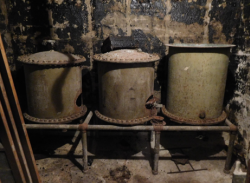Culture | December 7th, 2016

“When I used to go to Ralph’s, people would say that it used to be a speakeasy -- which is half true,” says Markus Krueger, Programming Director at the Historical and Cultural Society of Clay County, “it was two separate speakeasies, and every building on that block was a speakeasy, or they housed the people who worked there.”
He went on to say, “Three blocks surrounding first avenue north in Moorhead had almost as many places where you could illegally buy alcohol in 1927 as the seven blocks in downtown Fargo do today.” There are currently 16 establishments in the seven block radius of downtown Fargo where one can enjoy a brew--in prohibition era Moorhead there were 14 in a three block radius.
Kreuger was able to map out the locations of these “blind pigs” or maybe better known as speakeasies by looking at the arrest records of the era. Interestingly enough a handful of these former blind pigs are still in operation, now legally, the oldest of which houses the Rustica Eatery. Though the Mills Lounge in Dilworth is one, two of the three original bars are still in operation in Barnesville, as well as the notorious Empire in Downtown Fargo.
On December 8, the Empire will be celebrating 80 years. “The Empire has always been the Empire. They still have their liquor license framed up above the bar, ”Krueger says. “They know all of this stuff--and according to people that I’ve talked to that work there, they say it was an old speakeasy or blind pig during prohibition.”
“Wet & Dry Alcohol in Clay County 1871-1937” is currently on exhibit at The Historical and Cultural Society of Clay County. “It starts with our wild west birth through the saloon era, when North Dakota is dry so all of the saloons are in Moorhead. North Dakota prohibition just pushed all of the alcohol trade to the Minnesota side of the river.” Krueger says, “There was too much stuff to just throw away -- you can write a book on the wall and nobody will read it. The stuff that didn’t make it into the exhibit was just too good this time around so we decided to do a presentation series about different aspects of prohibition.”
Naturally the exhibit features artifacts of Fargo-Moorhead’s rowdy history, but it also features a growler from Junkyard brewery in addition to the clay jugs of distilleries past. “It's very cool to be a part of the local brewing history and to have our growler bottle in the Wet and Dry exhibit.” says Aaron Juhnke, proprietor of Junkyard Brewing Company in Moorhead, “That's our goal; to be around long enough to really become part of the history of this town. I don't think we're there yet, but having a part in the exhibit is a great sign.”
Juhnke, as well as a number of our favorite local brewers and distillers have been a part of the exhibit from the beginning. “They’ve been part of the exhibit process about a year before the exhibit even opened. Almost all of these people are interested in history.”
Krueger eventually reached out to Juhnke and his presentation series “History on tap” soon found a home at Junkyard.“I love doing presentations--I do them all of the time, but the thing that kind of scared me was doing a powerpoint presentation in a bar.” Krueger said.
“One of the coolest parts of this series is seeing the direct connection to people in the audience who are related to the historical figures that Markus is talking about. He will mention a family name like "Kaiser" or "Schumacher", and there have been folks in the audience that will respond or cheer to that.” Juhnke says, “The taproom has been getting packed full for these presentations, and after getting a beer in hand, everybody quiets down and pays close attention, so it's definitely a serious event, but very fun because everyone gets to drink beer at the same time.”
“Part of the reason I want to do the presentation series is because we’ve got to get these stories. All of the people who were drinking in speakeasies in Moorhead in the 1930s have died of old age.” Krueger says, “People who were kids during prohibition are in their 80s and 90s now -- but I have been getting good stories from the kids.”
Krueger spoke to one rumrunner’s daughter. “She remembers her dad hiding out from the mob when she was a kid -- though she is unsure of who. A lot of these stories have been lost.” She knew he was afraid of hijackings, kidnappings, and knew that the police could be bribed. He compares the plight of the Rumrunners and the Bootleggers to the pot dealers of today.
A rumrunner, a moonshiner, and a bootlegger are three entirely different entities. The rumrunner smuggled the illegal booze and the moonshiner produced illegal booze, all to supply the bootlegger. “Bootleggers work in small amounts of alcohol that are able to be hidden.” Krueger elaborates, “The common unit of booze that our great grandparents would buy was a ‘mickey,’ an 8oz glass flask that was able to be hidden in your clothing or the leg of your boot.”
“Her dad did not tell his daughters what happened. I got a lot of the information from his son-in-law. He’d tell the guys, but they said if their dad knew that people were talking about this, he would be rolling in his grave.” Krueger said.
IF YOU GO
History on Tap : Blind Pigs, Bootleggers and the Birth of Bars.
Monday, December 12, 6pm
Junkyard Brewing Company, 1416 1st Ave N, Moorhead
December 18th 2025
October 20th 2025
October 15th 2025
September 16th 2025
July 29th 2025
_(1)_(1)_(1)__293px-wide.jpg)
_(1)__293px-wide.png)
__293px-wide.jpg)
_(1)_(1)_(1)__293px-wide.jpg)
_(1)__293px-wide.jpg)
